“Global Retail Sourcing And Procurement Market to reach a market value of USD 14.5 Billion by 2031 growing at a CAGR of 15.8%”
The Global Retail Sourcing And Procurement Market size is expected to reach $14.5 billion by 2031, rising at a market growth of 15.8% CAGR during the forecast period.
The North America segment procured 35% revenue share in this market in 2023. The region’s advanced retail sector and widespread adoption of digital procurement technologies drive the market. North American retailers are early adopters of innovative solutions, including AI, cloud-based platforms, and automation, to optimize sourcing, enhance supply chain visibility, and drive cost efficiencies.
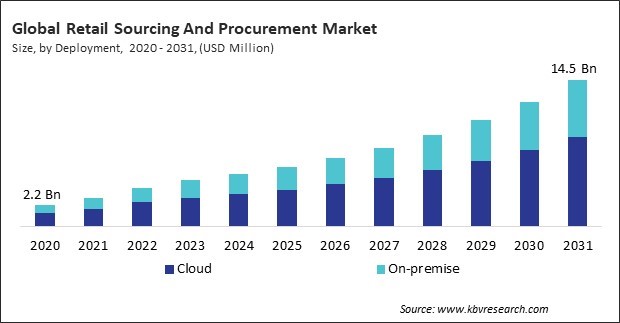
The major strategies followed by the market participants are Product Launches as the key developmental strategy to keep pace with the changing demands of end users. For instance, In May, 2024, GEP Software unveiled the industry's first AI-driven Total Orchestration Solution to enhance the user experience in procurement. Designed for non-procurement professionals, it simplifies complex workflows with a built-in co-pilot, enabling guided processes and improved visibility. This solution streamlines procurement, enhances collaboration, and optimizes enterprise spending through generative AI and low-code capabilities. Moreover, In June, 2024, Ivalua Inc. unveiled its External Workforce Management solution, allowing organizations to manage external workforce costs and risks alongside supplier spend. This solution addresses challenges in engagement processes, hidden expenses, and regulatory risks, providing enhanced visibility and insights to ensure effective management and a better return on investment for external talent.
Based on the Analysis presented in the KBV Cardinal matrix; Infor, Inc., Oracle Corporation, and SAP SE are the forerunners in the Retail Sourcing And Procurement Market. In June, 2024, Infor, Inc. unveiled the Procure-to-Pay process for direct procurement by providing a unified view of the supply chain. It automates document generation, purchase order management, and invoice approvals, leading to streamlined operations, reduced costs, better cash flow visibility, and improved supplier performance. Companies such as Blue Yonder Group, Inc., GEP Software, and Coupa Software, Inc. are some of the key innovators in Retail Sourcing And Procurement Market.
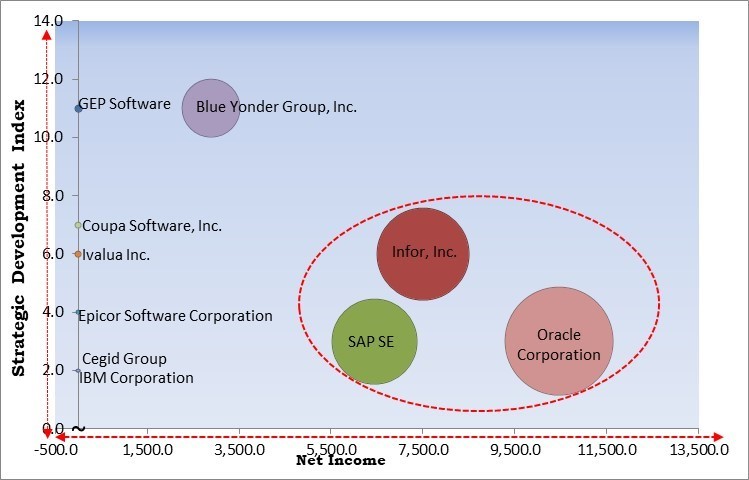
The shift to digital platforms enables retailers to leverage AI, analytics, and cloud-based solutions for better decision-making, real-time insights, and automated procurement processes, which boosts efficiency. AI, for instance, offers predictive insights into market trends, demand forecasting, and supplier performance, which can be critical for retailers aiming to manage inventory efficiently and avoid stockouts or overstocks. Hence, such factors will aid in the expansion of the market.
Additionally, Globalization has significantly expanded supply chain networks, allowing retailers to source products and materials from multiple locations worldwide. While this global reach offers opportunities for cost reduction and market access, it also adds complexity. Retailers now face logistical challenges such as coordinating suppliers across different regions, managing transportation, and ensuring that products reach consumers on time. Advanced sourcing and procurement solutions help streamline these processes by providing centralized visibility and tools for efficient coordination, which is essential to maintaining a smooth, global supply chain. Thus, these solutions will increase as globalization increases.
However, Implementing these systems often involves purchasing advanced software and substantial expenses related to infrastructure upgrades, employee training, and system customization to align with the organization's unique needs. For large corporations, these investments may be manageable within their broader budgets. However, SMEs, which operate on tighter financial margins, frequently find these upfront costs prohibitive, hindering their ability to adopt such systems. Hence, the high initial implementation costs remain a critical factor hampering the growth of this market.
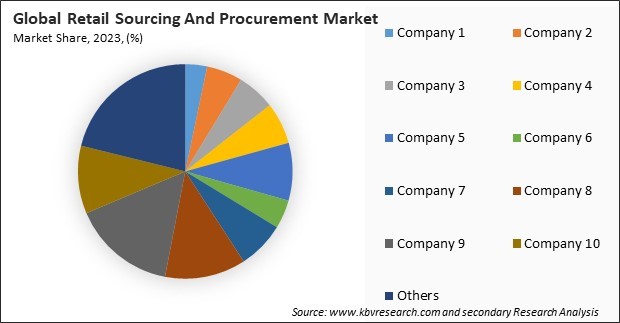
The leading players in the market are competing with diverse innovative offerings to remain competitive in the market. The above illustration shows the percentage of revenue shared by some of the leading companies in the market. The leading players of the market are adopting various strategies in order to cater demand coming from the different industries. The key developmental strategies in the market are Product Launches and Product Expansions.
On the basis of deployment, the retail sourcing and procurement market is classified into cloud and on-premise. The on-premise segment recorded 37% revenue share in this market in 2023. Retail companies seeking greater control over their data often prefer on-premise deployment, with concerns around data privacy and security driving this choice. Large enterprises and businesses in regulated industries may favor on-premise solutions to maintain compliance with data protection standards and retain full ownership of their procurement systems.
Based on component, the retail sourcing and procurement market is bifurcated into solution and service. The service segment procured 40% revenue share in this market in 2023. This segment encompasses consulting, implementation, support, and maintenance services, which are critical for successfully deploying and managing procurement solutions. Retail companies often rely on these services to guide complex implementations, ensure compliance with industry regulations, and maintain system performance, especially as they transition to more digital and automated procurement systems.
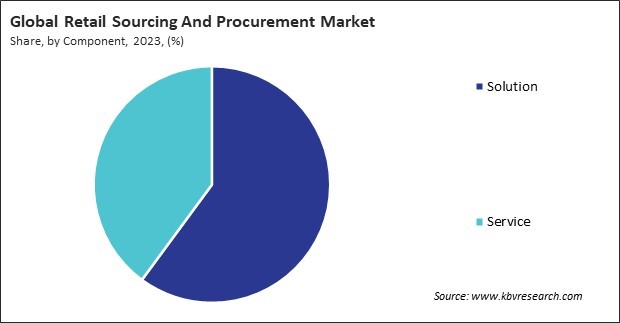
By enterprise size, the retail sourcing and procurement market is divided into large enterprises and small & medium enterprises. The small & medium enterprises segment garnered 38% revenue share in this market in 2023. As SMEs face increasing competition and aim to scale efficiently, they are adopting sourcing and procurement tools to gain better control over their supply chains and enhance cost-effectiveness. Cloud-based solutions offer affordability and scalability, especially appeal to SMEs, as they can quickly deploy these tools without extensive infrastructure investments.
Free Valuable Insights: Global Retail Sourcing And Procurement Market size to reach USD 14.5 Billion by 2031
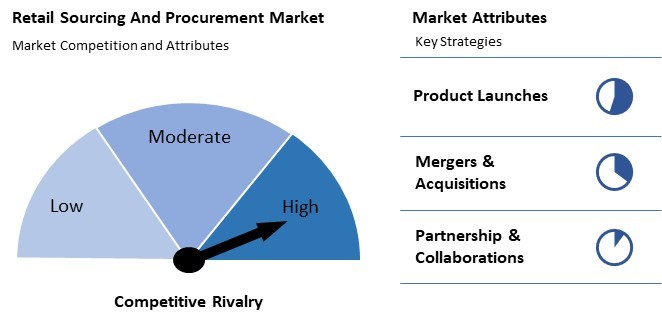
The Retail Sourcing and Procurement Market is characterized by a competitive landscape marked by numerous mid-tier and regional players. These companies leverage innovative technologies, data analytics, and agile supply chain practices to differentiate themselves. While they may lack the extensive resources of top key players, their focus on niche markets, personalized services, and local partnerships enables them to effectively compete and capture market share.
Region-wise, the retail sourcing and procurement market is analyzed across North America, Europe, Asia Pacific, and LAMEA. The Europe segment acquired 32% revenue share in this market in 2023. The regional market’s expansion underscores the region’s focus on digital transformation and sustainability in procurement practices. European retailers increasingly adopt cloud solutions and data analytics tools to manage sourcing operations and align with stringent data privacy and environmental sustainability regulatory standards.
| Report Attribute | Details |
|---|---|
| Market size value in 2023 | USD 4.6 Billion |
| Market size forecast in 2031 | USD 14.5 Billion |
| Base Year | 2023 |
| Historical Period | 2020 to 2022 |
| Forecast Period | 2024 to 2031 |
| Revenue Growth Rate | CAGR of 15.8% from 2024 to 2031 |
| Number of Pages | 311 |
| Number of Tables | 523 |
| Report coverage | Market Trends, Revenue Estimation and Forecast, Segmentation Analysis, Regional and Country Breakdown, Competitive Landscape, Market Share Analysis, Porter’s 5 Forces Analysis, Company Profiling, Companies Strategic Developments, SWOT Analysis, Winning Imperatives |
| Segments covered | Deployment, Component, Enterprise Size, Region |
| Country scope |
|
| Companies Included | Cegid Group, Epicor Software Corporation, GEP Software, Infor, Inc. (Koch Industries), IBM Corporation, Ivalua Inc., Blue Yonder Group, Inc. (Panasonic Holdings Corporation), Oracle Corporation, SAP SE, and Coupa Software, Inc. |
By Deployment
By Component
By Enterprise Size
By Geography
This Market size is expected to reach $14.5 billion by 2031.
Ongoing Digital Transformation In Retail are driving the Market in coming years, however, High Cost Of Implementation restraints the growth of the Market.
Cegid Group, Epicor Software Corporation, GEP Software, Infor, Inc. (Koch Industries), IBM Corporation, Ivalua Inc., Blue Yonder Group, Inc. (Panasonic Holdings Corporation), Oracle Corporation, SAP SE, and Coupa Software, Inc.
The expected CAGR of this Market is 15.8% from 2024 to 2031.
The Solution segment led the maximum revenue in the Market by Component in 2023, thereby, achieving a market value of $8.4 billion by 2031.
The North America region dominated the Market by Region in 2023, and would continue to be a dominant market till 2031; thereby, achieving a market value of $5 billion by 2031.
Our team of dedicated experts can provide you with attractive expansion opportunities for your business.

 Drivers
Drivers
 Restraints
Restraints
 Opportunities
Opportunities
 Challenges
Challenges
